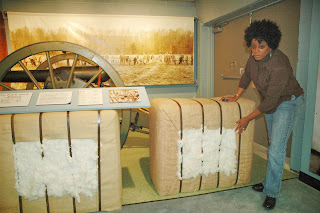 |
| Hardy Richardson, Administrator of the will |
Benjamin and Celia Bankston Richardson, 1852
File R-4
Sept. 18, 1852. Inventory, Present were: Augustus W. Hart, James McCoy, Robert W. Roberts, Alexander Courtney, Mrs. Celia Richardson, Stephen Richardson and major heirs Matthew, Stephen, and Francis E. Richardson. 640 acres on which the deceased last resided, bounded north by A. Courtney, east by bound Courtney, south by Davidson, west by Dennis including mills and gin--$4000; 23 slaves--$17,040; mill; horses; cattles; barouche--$100; 8 beds; etc. Total $24,178.
My great great grandfather Thomas Richardson, Jr., and his mother Carrie was part of this inventory. They appraised for $1100.00 dollars in 1853. My maternal grandmother Josephine Richardson was the grand daughter of Thomas Richardson, Sr., and the great-granddaughter of Carrie. Often times, "I find my mind drifting off on this period in the lives of my ancestors, but yet moving on to educate others in the family about our history in St. Helena Parish."
 |
| Thomas Richardson, Sr. Rocky Hill Cemetery, St. Helena Parish |
I knew all of my grandmother's sisters and brothers born to Thomas Richardson, Jr. and Emma Vining Richardson. I only wish that I spent more time talking with them about our history. My maternal great uncle Alexander Richardson share some of our history with his son Emmitt N. Richardson, Sr., My grandmother and her siblings were the grandchildren of slaves. They were the griots that had the family history--when they passed away so did part of our history.
The first time I walked inside the St. Helena Parish Clerk Office vault to conduct genealogy research, I couldn't stop looking at the the vaults. I knew that one of the vaults held information about my ancestors. It was a day of joy and sadness at the same time. Happy and sad tears was streaming down my face as if someone turned on a water faucet. Here I am decades later looking for information on my family. Who owned them? What plantation did they work and live on? Where did they purchase them from? Who are the missing people in the family that we haven't found. Most importantly, am I the only one who really cares? After locating their graves in Rocky Hill Church Cemetery and finding headstones on both Thomas Richardson, Sr., and his wife Amanda Breland Richardson, Thomas grave that clearly confirmed that Thomas Richardson, Sr., was born in slavery. I owe it to them to tell their story. It may not be important to anyone else, "it is important to me." I know that my ancestors would be rejoicing to know that I am telling their story to anyone who will listen.
 |
| From Right to Left Alexander Richardson, Alma Richardson Gordon, Josephine Richardson Harrell and Rosabell Richardson Moore |










































